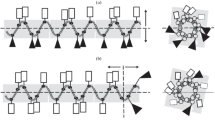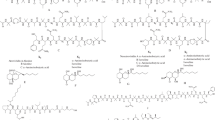Abstract
P18 (KWKLFKKIPKFLHLAKKF-NH2) is an antimicrobial peptide designed from a cecropin A-magainin 2 hybrid that has potent antibacterial activity without hemolytic activity against human erythrocytes. In this study, P18 displayed potent fungicidal activity (MIC: 12.5∼25 μm) against pathogenic fungi, Candida albicans, Trichosporon beigelii, Aspergillus flavus and Fusarium oxysporum. The central Pro9 residue and the entire sequence of P18 are essential for its full fungicidal activity. Circular dichroism analysis suggested that the higher α-helical content of the peptides did not correlate with the stronger fungicidal activity.
Similar content being viewed by others
References
Boman HG, Hultmark D (1987) Cell-free immunity in insects. Annu. Rev. Microbiol. 41: 103–126.
Chen YH, Yang JT, Chau KH (1974) Determination of the helix and beta form of proteins in aqueous solution by circular dichroism. Biochemistry 13: 3350–3359.
Dathe M, Wieprecht T, Nikolenko H, Handel L, Maloy WL, Mac-Donald DL, Beyermann M, Bienert M (1997) Hydrophobicity, hydrophobic moment and angle subtended by charged residues modulate antibacterial and haemolytic activity of amphipathic helical peptides. FEBS Lett. 403: 208–212.
Gesell J, Zasloff M, Opella SJ (1997) Two-dimensional 1 H NMR experiments show that the 23-residue magainin antibiotic peptide is an ?-helix in dodecylphosphocholine micelles, sodium dodecylsulfate micelles, and trifluoroethanol/water solution. J. Biomol. NMR 9: 127–135.
Holak TA, Engstrom A, Kraulis PJ, Lindeberg G, Bennich H, Jones TA, Gronenborn AM, Clore GM (1988) The solution conformation of the antibacterial peptide cecropin A: a nuclear magnetic resonance and dynamical simulated annealing study. Biochemistry 27: 7620–7629.
Mosmann T (1983) Rapid colorimetric assay for cellular growth and survival: application to proliferation and cytotoxicity assays. J. Immunol. Meth. 80: 14–20.
Oh D, Shin SY, Lee S, Kang JH, Kim SD, Ryu PD, Hahm KS, Kim Y (2000) Role of the hinge region and the tryptophan residue in the synthetic antimicrobial peptides, cecropin A(1-8)-magainin 2(1-12) and its analogues, on their antibiotic activities and structures. Biochemistry 39: 11855–11864.
Sheppard RC (1980) New solid-phase methods in the synthesis of natural peptides. Biochem. Soc. Trans. 8: 744–747.
Shin SY, Kang JH, Hahm K-S (1999) Structure-antibacterial, antitumor and hemolytic activity relationships of cecropin A-magainin 2 and cecropin A-melittin hybrid peptides J. Pept. Res. 53: 82–90.
Shin SY, Lee SH, Yang S-T, Park EJ, Lee DG, Lee MK, Eom SH, Song WK, Kim Y, Hahm K-S, Kim JI (2001) Antibacterial, antitumor and hemolytic activities of ?-helical antibiotic peptide, P18 and its analogs. J. Pept. Res. 58: 504–514.
Soravia E, Martini G, Zasloff M (1988) Antimicrobial properties of peptides from Xenopus granular gland secretions. FEBS Lett. 228: 337–340.
Steiner H, Andreu D, Merrifield RB (1988) Binding and action of cecropin and cecropin analogues: antibacterial peptides from insects. Biochim. Biophys. Acta 939: 260–266.
Zasloff M (1987) Magainins, a class of antimicrobial peptides from Xenopus skin: isolation, characterization of two active forms, and partial cDNA sequence of a precursor. Proc. Natl. Acad. Sci. USA 84: 5449–5453.
Author information
Authors and Affiliations
Rights and permissions
About this article
Cite this article
Lee, D.G., Hahm, KS. & Shin, S.Y. Structure and fungicidal activity of a synthetic antimicrobial peptide, P18, and its truncated peptides. Biotechnology Letters 26, 337–341 (2004). https://doi.org/10.1023/B:BILE.0000015472.09542.6d
Issue Date:
DOI: https://doi.org/10.1023/B:BILE.0000015472.09542.6d




